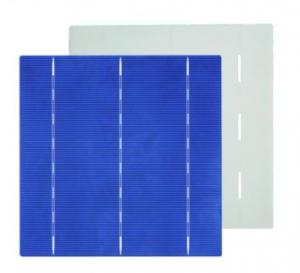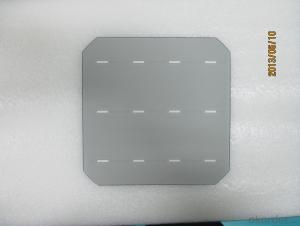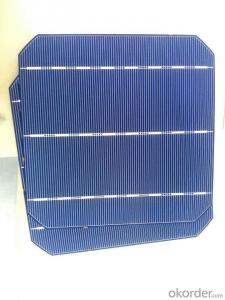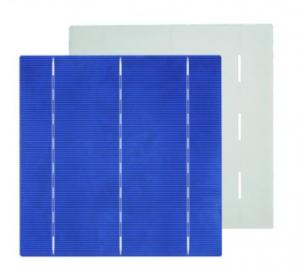Flexible Monocrystal Solar Energy Cell 156*156mm with 18% Efficiency
- Loading Port:
- China Main Port
- Payment Terms:
- TT or LC
- Min Order Qty:
- -
- Supply Capability:
- 1000000 pc/month
OKorder Service Pledge
OKorder Financial Service
You Might Also Like

Brief Introduction of Solar Cells
A solar cell, is an electrical device that converts the energy of light directly into electricity by the photovoltaic effect, which is a physical and chemical phenomenon. It is a form of photoelectric cell, defined as a device whose electrical characteristics, such as current, voltage, or resistance, vary when exposed to light. Solar cells are the building blocks of photovoltaic modules, otherwise known as solar panels.
Monocrystal Solar Energy Cell
type:156M
appearance:156×1565㎜±0.5mm;diagonal:R=100mm
Main fence wide:1.5mm back electrode wide:2.8mm
Fence line qty:90
Cell thickness:220um±20um
Eff(%) | 18.00- 18.10 | 18.10- 18.20 | 18.20- 18.30 | 18.30- 18.40 | 18.40- 18.50 | 18.50- 18.60 | 18.60- 18.70 | 18.70- 18.80 | 18.80- 18.90 | 18.9- 19.0 | 19.1- 19.1 | 19.1- 19.2 |
Pm(W) | 4.30 | 4.33 | 4.35 | 4.37 | 4.40 | 4.42 | 4.44 | 4.47 | 4.49 | 4.52 | 4.54 | 4.56 |
Isc(A) | 8.71 | 8.73 | 8.76 | 8.77 | 8.78 | 8.82 | 8.83 | 8.85 | 8.86 | 8.88 | 8.9 | 8.93 |
Im(A) | 8.19 | 8.21 | 8.24 | 8.26 | 8.30 | 8.33 | 8.35 | 8.39 | 8.42 | 8.45 | 8.47 | 8.51 |
Voc(V) | 0.630 | 0.631 | 0.632 | 0.633 | 0.634 | 0.634 | 0.635 | 0.636 | 0.637 | 0.637 | 0.638 | 0.64 |
Vm(V) | 0.527 | 0.528 | 0.529 | 0.531 | 0.531 | 0.532 | 0.534 | 0.534 | 0.535 | 0.536 | 0.537 | 0.538 |
FF(%) | 78.6 | 78.7 | 78.8 | 79.0 | 79.2 | 79.3 | 79.5 | 79.6 | 79.8 | 80 | 80 | 80 |

remark:our company cells as per working current concentrate principle,separate the first and the second grade
Factory Picture of Solar Cells


FAQ
We have organized several common questions for our clients,may help you sincerely:
What’s price per watt?
A: It’s depends on the quantity, delivery date and payment terms of the order. We can talk further about the detail price issue. Our products is high quality with lower price level.
Can you tell me the parameter of your solar cells?
We have different series of cells with different power output, both from c-si to a-si. Please take our specification sheet for your reference.
How do you pack your products?
We have rich experience on how to pack the panels to make sure the safety on shipment when it arrives at the destination.
Can you do OEM for us?
Yes, we can.
How long can we receive the product after purchase?
In the purchase of product within three working days, We will arrange the factory delivery as soon as possible. The perfect time of receiving is related to the state and position of customers. Commonly 7 to 10 working days can be served.
- Q: How many years should I spend in the solar cell industry to be a good solar cells sales person?
- Experience matter, but not the years. As long as you are learning the solar cells knowledge everyday, you can be a good solar cells sales in just one year.
- Q: Can solar cells be used in areas with high pollution?
- Yes, solar cells can be used in areas with high pollution. However, it is important to note that pollution can have a negative impact on the efficiency and performance of solar cells. Airborne pollutants, such as particulate matter and smog, can reduce the amount of sunlight reaching the cells, thereby decreasing their output. Regular maintenance and cleaning may be required to ensure optimal performance in polluted environments. Additionally, advanced solar cell technologies and designs are being developed to mitigate the effects of pollution and improve their efficiency in such areas.
- Q: Doping and Diffusion Principle in Solar Cell Processing
- The doping of semiconductors mainly relies on the principle of ion diffusion from high concentrations like low concentrations.
- Q: Can the 156x156mm high efficiency single crystal cells assembly function better compared to the traditional one?
- The reason why it is functioning better is because of its h igh power large area silicon solar cell.
- Q: Can solar cells be used on rooftops?
- Yes, solar cells can be used on rooftops. In fact, rooftop solar panels are a popular choice for residential and commercial buildings as they provide an efficient way to harness solar energy and generate electricity.
- Q: How do solar cells perform in areas with high levels of wildfire smoke?
- Solar cells can experience a decrease in performance in areas with high levels of wildfire smoke due to reduced sunlight reaching the surface. The smoke particles in the air can scatter and absorb sunlight, resulting in lower energy production. Additionally, the deposition of ash and soot on the solar panels can further reduce their efficiency. Regular cleaning and maintenance can help mitigate these effects to some extent.
- Q: Can solar cells be used for powering electric vehicle charging stations with battery storage?
- Yes, solar cells can be used to power electric vehicle charging stations with battery storage. Solar panels can generate electricity from the sun's rays, which can be used to charge electric vehicles directly or stored in batteries for later use. This enables sustainable and renewable energy sources to power the charging stations, reducing reliance on fossil fuels and minimizing carbon emissions.
- Q: Can solar cells be used in desert areas?
- Yes, solar cells can be used in desert areas. In fact, desert areas are considered ideal locations for solar power generation due to their high solar radiation levels and vast open spaces. The availability of ample sunlight ensures efficient energy production by solar panels, making them a viable and sustainable option for generating electricity in desert regions.
- Q: What is the expected degradation rate of a solar cell?
- The expected degradation rate of a solar cell can vary depending on various factors such as the quality of materials used, manufacturing processes, and operating conditions. On average, solar cells can experience a degradation rate of around 0.5-1% per year. However, with advancements in technology and better quality control measures, modern solar cells are designed to have lower degradation rates, often below 0.5% per year, ensuring their longevity and efficiency over time.
- Q: What is the role of surge protectors in solar cell systems?
- The role of surge protectors in solar cell systems is to protect the system from voltage spikes or surges that can damage the solar panels, inverters, or other sensitive electronic components. Surge protectors help to regulate and divert excessive voltage to prevent equipment failure and ensure the overall stability and longevity of the solar cell system.
Send your message to us
Flexible Monocrystal Solar Energy Cell 156*156mm with 18% Efficiency
- Loading Port:
- China Main Port
- Payment Terms:
- TT or LC
- Min Order Qty:
- -
- Supply Capability:
- 1000000 pc/month
OKorder Service Pledge
OKorder Financial Service
Similar products
Hot products
Hot Searches
Related keywords




























